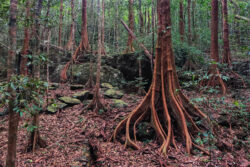It was post-lunch in mid-February 2012, when I received an email from Vijay Mohan Raj (popularly known as VMR) conveying that he had assumed a new office as the Field Director of Biligiri Ranga Temple Tiger Reserve (BRTTR). VMR also wanted to know more about Microhyla sholigari (Sholiga Narrow-mouthed Frog), the best time to see it, and whether I could come to BRTTR to show it to him. I was very excited, as this was a frog that had been elusive for 15 years; I had heard about it but had never seen it before. Losing no time, I responded in the affirmative.
The frog was first observed on 9th February 1997, along the Bhargavi stream bed near the Doddasampige tree and subsequently, on 10th September 1997. However, the paper describing Sholiga Narrow-mouthed Frog was published only in 2000 (Dutta and Roy, 2000). But to date, there was no other record of the frog after the original publication.
With the onset of the monsoon in 2012, I was immersed in searching for frogs in the Western Ghats and had almost forgotten about the Sholiga frog. Out of the blue, I received an invitation to visit BRTTR from Dr Aravind. He and his student Roshmi Sarma were working on land snails of that region. I was told that Roshmi had seen Microhyla ornata species in the ATREE field station’s kitchen. After a few discussions with Aravind and Roshmi, I and Priti decided to visit BRTTR. We hopped onto an early morning bus; the journey was scenic, with green fields on either side of the road. After Maddur, our bus kept stopping to transport school and college students till Kollegala. There onwards, it was filled with those travelling to BR hills; being a full-moon day, people were heading to BR hills to visit their local deity – Biligiriranga. As soon as we crossed Kollegala, the narrow roads opened into a dry deciduous forest.

Picturesque BR Hills
It was my first ever visit to BR hills, but Priti had been there before as a part of her PhD coursework. As soon as we crossed the forest check post, I became restless about getting down; with such a packed bus, it would be very difficult to move our instrument bags and luggage. Somehow, we managed to alight, but in a desolate ‘podu’ (Soliga settlement). Priti was afraid, as BRTTR was known for large carnivores and much larger herbivores. We could not contact Aravind as there was no network. I convinced Priti to walk, assuring her that we were close to the ATREE field station, as though I knew the place inside out! We had hardly moved when we were stopped by some patrolling forest guards; after listening to my boring story, they called Aravind to pick us up. When we reached our destination – the beautiful ATREE field station – we realised that we had alighted 10 km away from our actual destination!
After a sumptuous lunch, we planned our visit to Doddasampige, to begin our search. Doddasampige is a Kannada word (Dodda – giant, Sampige – Champaka) for a giant Champaka tree. It is worshipped by the Soliga tribe as a sacred grove.

The Doddasampige being worshipped by Soligas
We were a huge team of 14 people in search of a tiny frog. We searched for about three hours and could find species of Hylarana sp., Zakerana sp, and on our way back, Pseudophilautus sp and Duttaphrynus melanostictus. But, the Sholiga Narrow-mouthed Frog remained elusive.

The search team

Hylarana sp.
It was a very tiring search and we were all in dire need of a cup of tea. Luckily one of the forest guards brought us some black tea from a Soliga tribal’s home; the tea tasted very different and refreshed us. Suddenly it started raining, and the forest department officials decided to take us to the forest guest house, where they also arranged for dinner, after which we returned to the ATREE field station. Our first search ended on a low note and we returned to Bangalore disappointed.
It was early October when we decided to visit BR hills once again. This time, Dr Sudhira and his wife Ramya joined us. This second visit gave us an opportunity to visit some of the evergreen patches of BR hills. Being in the confluence of Western Ghats and Eastern Ghats, BR hills was picturesque.
After spending an entire day in the Sholas, we headed back to the ATREE field station by evening. As soon as we reached there, it started raining. We sat in the portico, discussing fieldwork, when suddenly, Priti screamed “Look at this tiny frog”, pointing her finger at a bush. We all jumped into the bush to get a good look at the frog. Lo and behold, we had found the Sholiga narrow-mouthed frog! Roshmi exclaimed that it was the same frog she had spotted in the ATREE kitchen a few weeks ago. Thrilled and excited, we photographed the frog and mailed the photos to VMR.
It was a proud moment for me to see an elusive species like Microhyla sholigari, which was last sighted in 1997. To find this frog in the ATREE field station and not in any dense forest made this search a memorable experience, something which will be ranked at the top of my field encounters! We thank VMR for the necessary permission to visit BRTTR.
Reference:
Dutta, S. K., and P. Ray. 2000. Microhyla sholigari, a new species of microhylid frog (Anura: Microhylidae) from Karnataka, India. Hamadryad. Madras 25: 38–44.
Co-authors:
Ms Priti H is a PhD student at ATREE working on landscape genetics in endemic frogs from the Western Ghats. Ms Roshmi RS is a PhD student at ATREE working on land snails. Ms Ramya B is Researcher with Gubbi Labs working on anuran acoustics and database. Dr Sudhira HS is Director, Gubbi Labs. Dr Aravind Madhyastha is a Fellow at ATREE and Dr Gururaja KV is Chief Scientist at Gubbi Labs.








Instagram
junglelodgesjlr